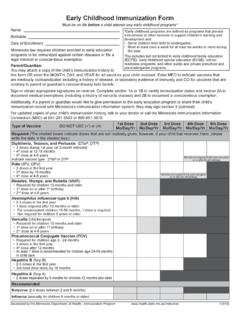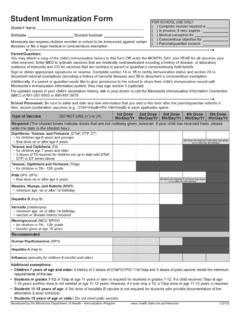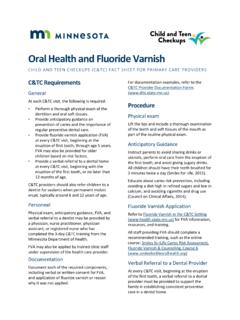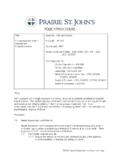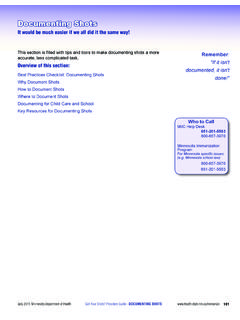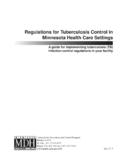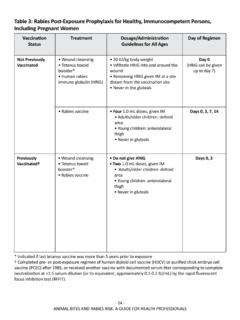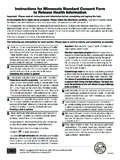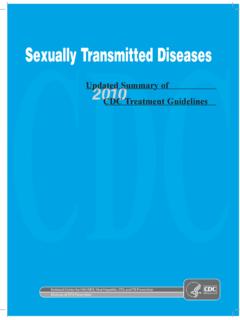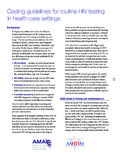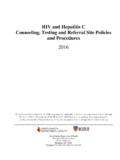Transcription of Clinical Guidelines for Syphilis during Pregnancy and ...
1 STD, HIV, AND TB SECTION (3/2016) Page 1 of 10 Clinical Guidelines for Syphilis during Pregnancy and congenital Syphilis , including Infants and Children Table of Contents Syphilis during Pregnancy .. 2 Diagnostic Considerations .. 2 Treatment .. 3 Other Management Considerations .. 3 Follow-Up .. 3 congenital Syphilis .. 4 Evaluation and Treatment of Neonates (Infants Aged 30 Days) .. 4 Follow-up .. 8 Special Considerations .. 8 Evaluation and Treatment of Infants and Children .. 9 Follow-Up .. 9 Special Considerations .. 10 Clinical Guidelines FOR Syphilis during Pregnancy AND congenital Syphilis , INCLUDING INFANTS AND CHILDREN (3/2016) Page 2 of 10 Syphilis during Pregnancy All women should be screened serologically for Syphilis early in Pregnancy .
2 Testing should be performed three times; at the first prenatal visit, at 28 -32 weeks gestation and at delivery. Any woman who has a fetal death after 20 weeks should be tested for Syphilis . No mother or neonate should leave the hospital without maternal serologic status being documented at least once during Pregnancy and documented at delivery. In high-risk populations who receive inconsistent prenatal care, serology should be done at the first prenatal visit and treatment started as soon as serologic results are available. Diagnostic Considerations In general, the risk for antepartum fetal infection or congenital Syphilis at delivery is related to the mother s stage of Syphilis during Pregnancy , with the highest risk being with the primary and secondary stages.
3 Quantitative maternal nontreponemal titer, especially if 1:8, might be a marker of early infection and bacteremia. Early Syphilis is defined as seroreactivity without Clinical signs and symptoms acquired within the last year. Risk for fetal infection is still significant in pregnant women with stable, serofast low antibody titers who have been treated for Syphilis might not require additional treatment; however; rising or persistently high antibody titers might indicate reinfection or treatment failure and treatment should be considered If a treponemal test ( EIA or CIA) is used for antepartum Syphilis screening, all positive tests should be reflexed to a quantitative nontreponemal test (RPR, VDRL or USR). If the nontreponemal test is negative, then the results are considered discrepant and a second treponemal test (TP-PA preferred) should be performed, preferably on the same specimen.
4 If the second treponemal test is positive, current or past Syphilis infection can be confirmed. Women with a documented history of adequate treatment for Syphilis , who do not have an ongoing risk, no further treatment is necessary. Women without a documented history of treatment should be staged and treated accordingly with a penicillin regimen. If the second treponemal test is negative, the positive EIA/CIA is more likely to represent a false positive test result in low-risk women with no history of treated Syphilis . If the woman is low risk for Syphilis , has a partner with no Clinical or serologic evidence of Syphilis , and is likely to follow-up, repeat serologic testing within 4 weeks can be considered. If both the RPR and TP-PA remain negative, no further treatment is necessary.
5 If follow-up is not possible, women without a documented history of treated Syphilis should be treated according to the stage of Syphilis . Clinical Guidelines FOR Syphilis during Pregnancy AND congenital Syphilis , INCLUDING INFANTS AND CHILDREN (3/2016) Page 3 of 10 Treatment Penicillin G is the only known effective treatment to prevent maternal transmission to the fetus and treating fetal infection. Pregnant women should be treated with the penicillin regimen appropriate for their stage of infection. Pregnant women who report penicillin allergy should be desensitized and treated with penicillin. Missed doses are NOT acceptable for pregnant women receiving therapy for late latent Syphilis . Pregnant women who miss any dose of therapy must repeat the entire course of therapy.
6 Other Management Considerations Syphilis diagnosed during the second half of Pregnancy should be treated as recommended. Management of therapy should also include a sonographic fetal evaluation for congenital Syphilis . Sonographic signs of fetal or placental Syphilis include; hepatomegaly, ascites, hydrops, fetal anemia or a thickened placenta; indicate greater risk of fetal treatment failure. Cases accompanied by these signs should be managed in consultation with obstetric specialists. Women treated for Syphilis during the second half of Pregnancy are at risk for premature labor and/or fetal distress if the treatment precipitates the Jarish-Herxheimer reaction. These women should be advised to seek immediate obstetrical attention after treatment if they notice any fever, contractions or decrease in fetal movements.
7 All women who have Syphilis should be offered testing for HIV infection. Follow-Up Coordinated prenatal care and treatment are critical: Repeat serology at 28 -32 weeks and at delivery at a minimum Repeat titers can be checked monthly for women at high risk for reinfections or in geographical areas where prevalence of Syphilis is high Ensure that Clinical and antibody responses are appropriate for the patient s stage of disease. Most women will deliver their babies before their response to treatment can be assessed definitively and will require continued follow-up post- partum. Their babies will require through assessment, possible treatment and close follow-up. Clinical Guidelines FOR Syphilis during Pregnancy AND congenital Syphilis , INCLUDING INFANTS AND CHILDREN (3/2016) Page 4 of 10 congenital Syphilis Identification of Syphilis in pregnant women is vital to effectively prevent and detect congenital Syphilis .
8 Routine serologic screening of pregnant women during their first prenatal visit, at 28-32 weeks and at delivery. As part of prenatal care for a woman who has Syphilis , information concerning ongoing risk behaviors and treatment of sex partners should be obtained to assess the risk of reinfection. Routine screening of newborn sera or umbilical cord blood is not recommended, as diagnosis at this time does not prevent symptomatic congenital Syphilis in some newborns. No mother or newborn infant should leave the hospital without maternal serologic status having been documented at least once during Pregnancy and preferably again at delivery if at risk. Evaluation and Treatment of Neonates (Infants Aged 30 Days) Transfer of maternal nontreponemal and treponemal IgG antibodies through the placenta to the fetus, can makes diagnosis of congenital Syphilis complicated.
9 Therefore, treatment decisions frequently must be made on the basis of: Identification of Syphilis in the mother. Adequacy of maternal treatment. Presence of Clinical , laboratory or radiographic evidence of Syphilis in the neonate. Comparison of maternal (at delivery) and neonatal nontreponemal serologic titers using the same test, preferably conducted by the same laboratory. Any neonate at risk for congenital Syphilis should receive a full evaluation and testing for HIV infection. All neonates born to mothers who have reactive nontreponemal and treponemal test results should be evaluated with a quantitative nontreponemal serologic test (RPR or VDRL) performed on the neonate s serum, because umbilical cord blood can become contaminated with maternal blood and yield a false-positive result.
10 Wharton s jelly within the umbilical cord can yield a false-negative result. Conducting a treponemal test ( , TP-PA, FTA-ABS, EIA, or CIA) on neonatal serum is not recommended because it is difficult to interpret. All neonates born to women who have reactive serological tests for Syphilis should be examined thoroughly for: Evidence of congenital Syphilis , , nonimmune hydrops, jaundice, hepatosplenomegaly, rhinitis, skin rash and pseudoparalysis of and extremity. Pathological examination of the placenta or umbilical cord using specific staining ( , silver) or a T. pallidum PCR test using a CLIA-validated test should be considered. DFA-TP reagents are not available. Darkfield microscopic examination or PCR testing of suspicious lesions or body fluids ( , bullous rash and nasal discharge) also should be performed.

